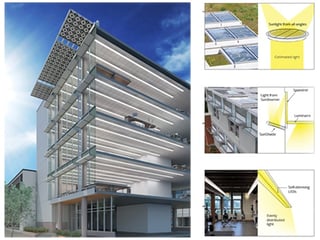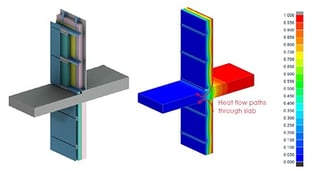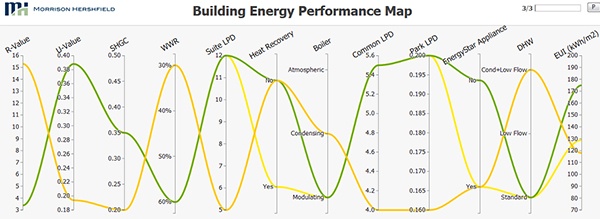Technical Paper: BEST4 Conference Produces Three Papers on Building Performance
Morrison Hershfield staff published three papers this April at the BEST4 Conference in Kansas City, Missouri. The quartet of Christian Cianfrone, Patrick Roppel, Radu Postole and Neil Norris worked alongside other subject matter experts presented the following:
Performance of Sealed Curtain Wall Spandrel Panels and Directing Natural Sunlight Deep into Multistory Buildings
Radu Postole, Building Science Consultant, Morrison Hershfield, Burnaby, BC
Patrick J, Roppel, Building Science Specialist, Morrison Hershfield, Burnaby, BC
Neil Norris, Building Science Consultant, Morrison Hershfield, Burnaby, BC
Kasra Bigdeli, Mechanical Engineer, SunCentral Inc, Richmond, BC
 A novel solution to overcome problems associated with the use of excessive window areas and shallow floor plates for daylighting buildings is to use active sunlight tracking systems to deliver controlled sunlight to areas that are inaccessible by conventional methods. This technology is commercially available to designers with minimal limitations to building orientation and form.
A novel solution to overcome problems associated with the use of excessive window areas and shallow floor plates for daylighting buildings is to use active sunlight tracking systems to deliver controlled sunlight to areas that are inaccessible by conventional methods. This technology is commercially available to designers with minimal limitations to building orientation and form.
The technology tracks the sun at the top of the building with an array of motorized mirrors and redirects a stationary beam of sunlight to concentrating optics located in sunshades and spandrel panels on each floor of the building. The concentrated beam of sunlight from the spandrel is distributed through the building using hybrid light pipe technology and fixtures.
This paper addresses the challenges of integrating an optical system into the building envelope, including limitations on insulation thickness, requirement for clear glass to the exterior and interior of the spandrel, and controlling dust and moisture within the spandrel to maintain the effectiveness of the optics. By means of analysis, testing, and validation, this system is compared with conventional curtain wall spandrels for controlling heat, air, and moisture.
To read more and download the entire paper, click here.
Holistic Approach to Achieving Low-Energy High-Rise Residential Buildings
Christian Cianfrone, Building Energy Specialist, Morrison Hershfield, Burnaby, BC
Patrick J, Roppel, Building Science Specialist, Morrison Hershfield, Burnaby, BC
Dieter Hardock, Product Manager, Schöck Bauteile GmbH, Baden-Baden, Germany
 As codes and standards evolve towards low- or net-zero energy buildings, the practicality of achieving these targets in high-rise concrete construction gets increasingly challenging. High-rise residential buildings are becoming more common as cities redevelop and add density. Current design and construction practice for high-rise MURBs presents a number of constraints with regards to achieving high levels of energy performance. These practice issues typically include;
As codes and standards evolve towards low- or net-zero energy buildings, the practicality of achieving these targets in high-rise concrete construction gets increasingly challenging. High-rise residential buildings are becoming more common as cities redevelop and add density. Current design and construction practice for high-rise MURBs presents a number of constraints with regards to achieving high levels of energy performance. These practice issues typically include;
- the desire to maximize glass to enhance marketability, daylight, and views;
- the desire to provide access to the outdoors via extended balconies;
- the need for Code-mandated non-combustibility and life safety requirements;
- a preference for building systems that minimize exterior construction access and streamlines construction sequencing;
- the adoption of increased structural load requirements, and/or
- the drive to minimize initial capital costs.
The outcome of these combined constraints is often poor energy efficiency, with the burden of higher operating costs deferred to future owners. There has been significant industry discussion on the poor energy performance of this class of building but there is very little guidance or long-term factual strategic information beyond broad principles of minimizing glazing areas, maximizing glazing performance, increasing air-tightness, and adding more insulation to opaque areas. This paper explores the prospect of energy-use becoming a primary consideration in high-rise residential buildings and what that will likely mean for the typical competing constraints mentioned above.
This paper utilizes the current common construction practices for concrete-framed, high-rise residential buildings in heating dominated climates (ASHRAE Zones 4 to 7) as a baseline to evaluate the impact of the interconnected variables related to reducing overall heating energy use. The objective is to weigh the impact of individual improvements against integrated bundles of measures to develop a roadmap and a better understanding of a practical path towards low energy, high-rise residential buildings. The paper focuses on solutions related to building envelope performance but from a holistic perspective that recognizes the interaction and contribution of mechanical systems typical of this construction type. The building envelope parameters covered includes glazing performance (for both conventional and innovative technologies) and opaque wall performance (with a focus on specific details to reduce thermal bridging rather than increasing insulation levels). The analysis presented draws upon three dimensional (“3D”) thermal modeling, whole building energy analysis, field testing and monitoring, and typical construction costs. The goal is to develop realistic targets for high-rise buildings and identify improvements that can be arrived at by market forces rather than those that can only be realized through more stringent and enforceable codes and standards.
To read more and download the entire paper, click here.
The Reality of Quantifying Curtain Wall Spandrel Thermal Performance: 2D, 3D and Hotbox Testing
Neil Norris, Larry Carbary, Stanley Yee, Patrick Roppel, Phillip Ciantar

This presentation details three methods for Hot Box Testing, per ASTM C1363; 2D Modeling, and 3D Modeling, and compares test results for five different spandrel assemblies. It also discusses Vacuum Insulated Panels(VIPs) and Architectural Insulated Modules (AIM), which are architectural units with customized performance, dimensions, and finish. The AIM unit assemblies, it explains,show significant improvement in thermal resistance over the typical spandrel systems. This offers great potential towards creating improved curtain wall systems.
To read more and download the presentation, click here.
Posts by Topic
Topics
- 5G (1)
- ACEC (3)
- Active Transportation (5)
- AFP/P3 (6)
- Alberta (5)
- Anniversary (1)
- approvals (1)
- Architect (2)
- Atlanta (2)
- Awards (62)
- Biophysical Sciences (1)
- Board of Directors (1)
- Bridge Rehabilitation (3)
- Building and Facilities Engineering (2)
- Building Energy (25)
- Building Envelope (48)
- Building Science (65)
- Calgary (2)
- Canada 150 (1)
- Canstruction (2)
- Capabilities (1)
- Carbon emissions (2)
- Carbon Pathfinder Tool (1)
- Carson Awards (5)
- Charity (13)
- Climate Adaption (7)
- climate change (7)
- Code and Life Safety (8)
- Commercial Buildings (4)
- Commissioning (11)
- Construction (2)
- Construction Administration (5)
- Consulting Engineering (1)
- Critical Facilities (33)
- CSR (24)
- Culture (5)
- Dallas (1)
- Data Center (22)
- Data Center Commissioning (9)
- Data Center Design (12)
- design (9)
- Design Build (1)
- DSSP (1)
- edgecomputing (1)
- edgetechnologies (1)
- Edmonton (4)
- Electrical (24)
- Electrical engineering (8)
- Energy (8)
- Engineers Canada (5)
- Environmental (36)
- Environmental Compensation (1)
- Environmental Impact Assessment (3)
- environmental planner (3)
- Environmental Planning (5)
- ETFE (1)
- Event (12)
- Existing Buildings (6)
- Facade Engineering (4)
- Ferry Docks (2)
- FIDIC (3)
- fisheries biologist (1)
- Flood Mapping (1)
- Florida (1)
- Forensic Investigation (1)
- Fundraising (11)
- garage (2)
- Gender Diversity (8)
- Gender Intelligence (3)
- Geometric Design (2)
- Government (14)
- Hospitality (1)
- Houston (4)
- Hydro (2)
- India (1)
- industrial (4)
- Infrastructure (28)
- Innovation (1)
- interchange (1)
- IWD (2)
- IWD2021 (1)
- Land Development (8)
- Landfill (4)
- Manitoba (1)
- MCF (3)
- Mechanical (21)
- Mechanical Engineering (1)
- MEP (1)
- mission critical (10)
- Moncton (1)
- Motivational MH'er (1)
- Multi-Use Pathways (1)
- Municipal Infrastructure (5)
- municipal solid waste (2)
- MUP (1)
- New Brunswick (1)
- New Hire (17)
- New Role (3)
- Newsroom (121)
- northern communities (2)
- NVTC (2)
- ontario (1)
- Operations Consulting (8)
- Ottawa (2)
- Panel (3)
- People (124)
- Project Management (6)
- QAP (1)
- Rail (1)
- Reconstruction (1)
- regulatory (1)
- Renewable Energy (2)
- resiliency (3)
- Risk Management (1)
- Roads and Highways (3)
- Salt Lake City (1)
- Seattle (1)
- Security (4)
- Social Responsibility (30)
- Solid Waste (11)
- solid waste management (5)
- St Johns (2)
- Stantec (1)
- Structural (14)
- Sustainability (23)
- Telecom (9)
- Texas (1)
- Toronto (13)
- towers (1)
- Traffic Assessment (2)
- Transfer Station (1)
- Transit (13)
- Transit Consultant (3)
- Transit Infrastructure (3)
- Transit Planning (2)
- Transportation (30)
- Transportation Engineering (8)
- transportation structures (2)
- TTC (1)
- Vancouver (6)
- Virginia (2)
- Washington DC (3)
- Waste to Energy (2)
- Water & Wastewater (8)
- Water Resources (3)
- wellfield (1)
- wellness challenge (1)
- Whistler (1)
- Whitehorse (1)
- Wireless (2)
- Women in Engineering (5)
- Yukon (5)